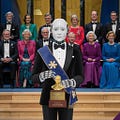Next Week in The Sequence:
Edge 439: Our series about state space models continues with a review of Zamba, a model that combines SSMs and attention layers. We review the original Zamba paper published by the Zyphra team and LitServe framework for model serving.
Edge 440: We discuss EUREKA, a recent foundation model evaluation framework published by Microsoft.
You can subscribe to The Sequence below:
📝 Editorial: AI Dropped the Mic at the Nobel Party
The 2024 Nobel Prizes have thrown the scientific community into a delightful tizzy with some drama included AI waltzed onto the stage, grabbing not one but two prestigious awards – physics and chemistry
The honorees?
Geoffrey Hinton and John Hopfield for their groundbreaking work on Boltzmann machines and The Hopfield networks respectively. The Chemistry prize was awarded to DeepMind’s Demis Hassabis and John Jumper for their protein-structure-predicting AlphaFold in chemistry.
But oh, the whispers, the gasps, the outright indignation! Some physicists, their feathers ruffled, cried foul. Machine learning winning a physics Nobel? Preposterous! They argue that machine learning, while undeniably powerful, is a child of computer science, not physics. Awarding it the physics prize, they say, feels like handing the Nobel in Literature to a particularly eloquent chatbot( which might happen soon enough btw). The chemistry prize was less debate. After all, its hard to argue AlphaFold’s impact in the space.
Yet, many scientists are applauding, seeing this as a beautiful blurring of lines, a testament to the interconnectedness of knowledge. After all, Hinton and Hopfield's work, like a masterful conductor, harmonized physics, math, computer science, and neuroscience. And AlphaFold, that protein-whispering AI, wouldn't exist without the decades of painstaking work in structural and computational biology, including the Protein Data Bank, a treasure trove of over 200,000 protein structures, some of which even helped win previous Nobels.
So, is AI crashing the Nobel party or simply adding its unique flair? Perhaps it's both. This controversy underscores the dynamic dance between science and technology, a dance that constantly reshapes the boundaries of knowledge. As AI continues its meteoric rise, expect more such debates, more intellectual waltzes, and more Nobel-worthy breakthroughs that blur the lines between disciplines. It's a thrilling time to be a scientist, even if it means occasionally stepping on each other's toes on the dance floor.
One interesting version of this is that the Nobel Prize should be upgraded to include categories such as mathematics, computer science and even a specific category for AI. It is a known fact that Alfred Nobel's lack of interest in mathematics but its been 123 years so you can say its time for a change.
Like it or not, AI winning two Nobel prizes like the scientific equivalent of a mic drop in the Nobel party.
🔎 ML Research
VQAScore
Carnegie Mellon University(CMU) published a paper introducing VQAScore, a new evaluation metric for determining the quality of text-to-image models. The research also introduces GenAI-Bench, a dataset to streamling the evaluation of generative vision models —> Read more.
MLE-Bench
OpenAI published a paper detailing MLE-Bench, a benchmark for measuring AI agent’s performance in ML engineering tasks. The benchmark in based on Kaggle competition and includes aspects such as model training, dataset preparation and experiment execution —> Read more.
LLMs Know More Than They Show
Google and Apple Research collaborated on a paper about hallucinations in LLMs. The paper outlines some fascinating discoveries including the fact that LLMs encode much more information about truthfulness that we realize and that this information is concentrated in specific tokens —> Read more.
Erasing Conceptual Knowledge from LLMs
Researchers from Anthropic and Northeastern University published a paper introducing Erasure of Language Memory (ELM), a new technique to erase conceptual information from LLMs. ELMs incorporates three fundamental forms of concept erasure: innocence (complete knowledge removal), seamlessness (maintaining conditional fluent generation), and specificity (preserving unrelated task performance) —> Read more.
Pixtral 12B
Mistral published a paper sharing the details behind Pixtral, its multimodal LLM unveiled last month. Pixtral uses a vision encoder trained from scratch as well as a very innovative text model which allows it to process both images and documents with a high level of performance —> Read more.
Augmented Object Intelligence
Google Research published a paper detailing Augmented Object Intelligence(AOI) that makes physical objects interactive in digital environments. AOI is a new interaction paradigm that leverages multimodal LLMs with real time object classification and segmentation —> Read more.
🤖 AI Tech Releases
Anthropic Message Batches
Anthropic introduced its Message Batches API that enables the processing of large volume queries asynchronously —> Read more.
Gradio 5
Hugging Face open sourced Gradio 5, its platform to build AI-driven web applications —> Read more.
Pamyra X 004
Writer released Pamyra X 004, a new model optimized for function calling —> Read more.
🛠 Real World AI
Time Series Data at Netflix
Netflix details their internal architecture for time series data —> Read more.
Amazon Rufus
Amazon discusses the AI behind Rufus, its popular shopping assistant —> Read more.
📡AI Radar
Google DeepMind’s Demis Hassabis and John Jumper were awarded the Nobel Prize in Chemistry.
AI legends Geoffrey E. Hinton and John J. Hopfield were awarded the Nobel Prize in Physics.
AI agent startup Sierra is raising capital at a $4 billion valuation.
Enterprise AI testing platform Distributional raised a $19 million Series A.
Cartesia added support for 8 languages to its Sonic model.
AI for biology platform Basecamp Research announced $60 million in new funding
AI acocunting platform Numeric raised $28 million in new funding.
Walmart introduced a new suite of LLMs focused on retail scenarios.
Scope3 raised $25 million for tracking the carbon footprint of AI.
Relyance AI raised $32 million to help companies comply with data regulations.
TMSC posted an impressive 39% increase in quaterly revenue based on the demand for AI chips.
Inflection AI unveiled new enterprise capabilities.
AI for sales startup Unify raised $12 million in a Series A.
AIOps platform VESSL AI raised $12 million in new funding.


